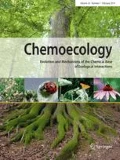Summary.
To exploit biologically active compounds from white clover (Trifolium repens L.) for suppressing weeds and soil-borne diseases, either as isolated products (biopesticides) or through cultivars with enhanced production of these compounds, the biologically active compounds must be identified, plant content measured, and their fate in soil known. The present review summarizes the published knowledge needed for such exploitation; providing essential information on structure and concentration of flavonols, flavones, condensed tannins, isoflavones, isoflavanones, pterocarpans, coumestans, cyanogenic glucosides, and saponins in healthy and stressed white clover plants. Various stresses and particular cultivars affect the concentrations of several of the compounds. Information on biological effects and the degradation/transformation of these compounds in plants or by microorganisms is available. There is no information on the degradation pathway in soil, the mechanisms of exudation and leaching of compounds from plants, and soil sorption properties of the compounds. The clover soil fatigue problem is increasing in grasslands and causes problems especially in organic farming. Research efforts focused on biological elements of clover soil fatigue have not explained it, and the influence of secondary metabolites has not been investigated. There are few investigations into the interaction between beneficial fungi/fungal-diseases and the occurrence of biologically active secondary metabolites in white clover plants. Such studies are critical to better understand beneficial fungi and pathogens.
Similar content being viewed by others
Author information
Authors and Affiliations
Corresponding author
Rights and permissions
About this article
Cite this article
Carlsen, S.C.K., Fomsgaard, I.S. Biologically active secondary metabolites in white clover (Trifolium repens L.) – a review focusing on contents in the plant, plant–pest interactions and transformation. Chemoecology 18, 129–170 (2008). https://doi.org/10.1007/s00049-008-0402-7
Received:
Accepted:
Published:
Issue Date:
DOI: https://doi.org/10.1007/s00049-008-0402-7




